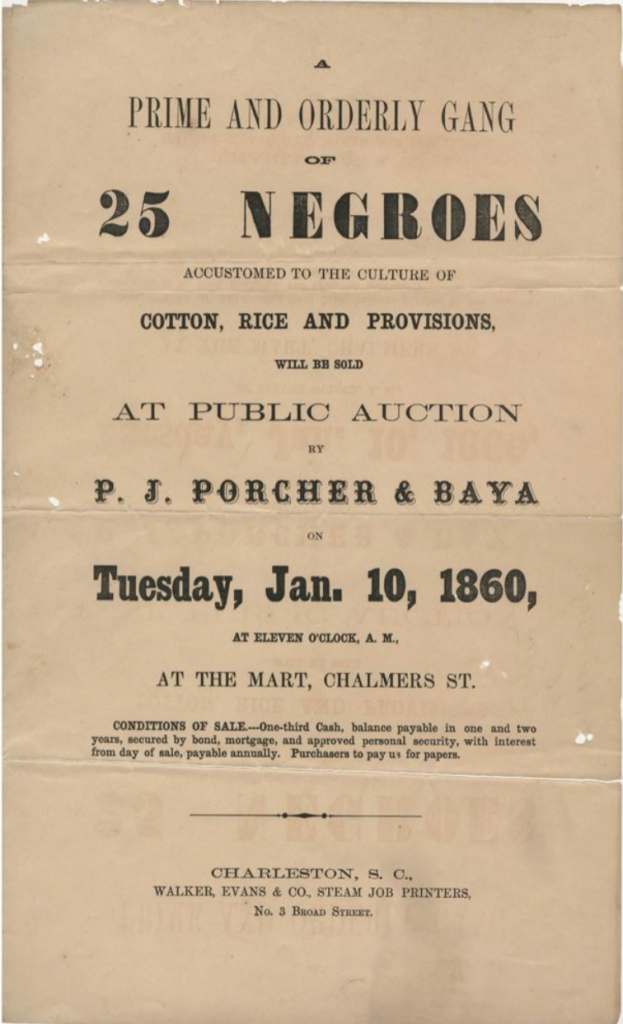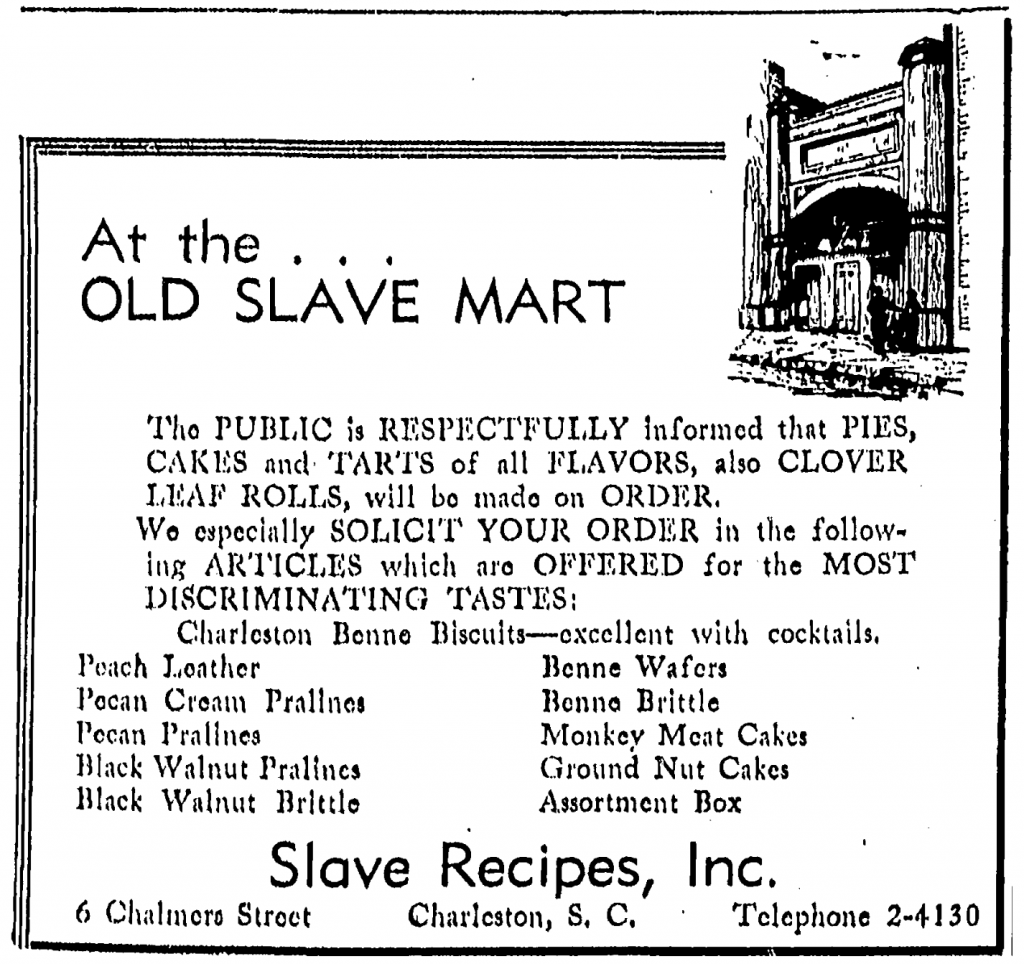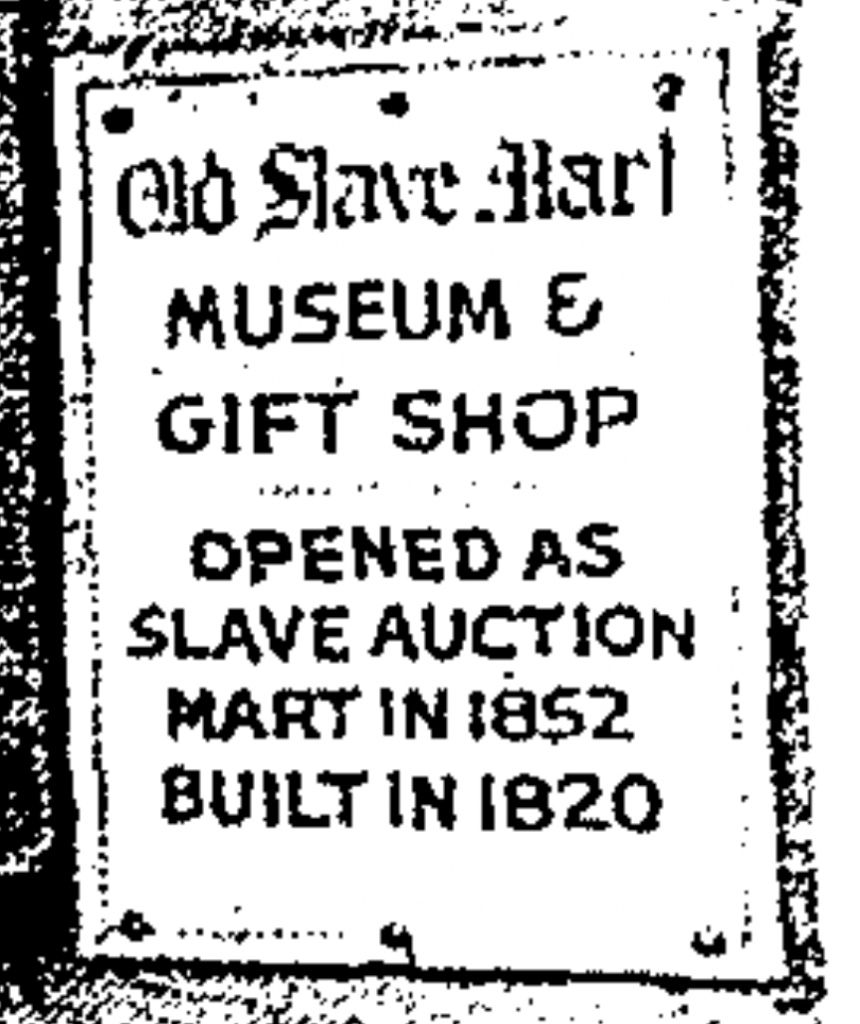» Part 2: Old Slave Mart and Charleston’s Historic Memory by Mateo Mérida
After the Civil War, Charleston would seek to rebuild from the damages of the Civil War, and find ways to adapt to an economy that was not predicated on the labor of enslaved people. The federal government would consider—and sometimes implement—policies that sought to uplift the people who were once enslaved as full citizens of the United States. However, for every one step forward, there were often two steps back. The federal government implemented voting rights, so the South created poll taxes and literacy tests. Black men would become prominent Wilmington government officials, so Southerners staged the only successful coup in US history.1 The federal government prohibited slavery, so Southern planters created sharecropping. Reconstruction created an atmosphere that rebuilt the South, but it did not seek to recognize or heal from the trauma of slavery.2
Still, even though Reconstruction, the use of the site as a tenement home, and an auto shop, the memory of what once was Ryan’s Mart did not fade away. In fact, it was a memory that was deeply reviled by Charleston’s intellectual elite. Thomas P. Lesesne was the chief editor of the Charleston News and Courier, and also wrote Landmarks of Charleston. After describing the distinctive cobblestone street of Chalmers street, he describes “…and on it is a building that tourists are told was the old Slave Market. The myth has been exploded repeatedly, but it persists, and since there are no black slaves it probably doesn’t matter.”3 Here, Lesesne is practicing historical erasure to a touristic audience, and describing it as fact. As if flatly rejecting the history of enslaved people was not enough, by writing a guide to visitors, Lesesne is tasking his readers to remember 6 Chalmers the same way.

Unfortunately for Lesesne, his claim that the occurrence of slave auctions at 6 Chalmers street is not substantiated by evidence is a claim that is not substantiated by evidence. In fact, there are mountains of evidence to the contrary. Had he made any effort to pursue the information, he would have found collections of broadsides that all list 6 Chalmers, or “the Mart at Chalmers” as the site for the auction it advertised By attempting to dismiss the history of auctions on 6 Chalmers, Lesesne is seeking to distance the site—and consequently Charleston as a whole—from its legacy of slavery. With Landmarks being written in 1939, Charleston was deeply steeped in the Jim Crow apartheid, which operated through the guise of “separate but equal,” but functioning as a system of oppression. By ignoring the very real history of what once was Ryan’s Mart, Lesesne is able to overlook the suffering of Black Charlestonians contemporaneously with the writing of his book.4
Jim Crow was not the only element that coincided with the writing of Landmarks, as 6 Chalmers had become a museum. In 1920, Marian B. Wilson had moved to Charleston from the outskirts of Cincinnati, OH, and purchased 6 Chalmers in 1937, and turned it into a museum, based on items she claimed to have been original to the site. As the curator of the Old Slave Mart Museum, Wilson was a well-known spokesperson of the history of slavery in Charleston, and was seen as a credible source of information. Further, she prided herself in presenting her museum with some of the best scholarship and research of her time.5
Wilson is credited in having created one of the very first Black history museums in the entire United States, however, it certainly had glaring flaws. In the early years of Wilson’s ownership of 6 Chalmers, she had used the space as a bakery, advertising the baked goods as “Slave Recipes.”6 In this way, Wilson commodified the site’s legacy of slavery, using it as a ploy to reap a profit through the sale of the baked goods. But she did not only commodify the legacy of violence. As a museum, she neglected to discuss the trauma of slavery at all, instead using the museum to discuss the products enslaved people created.

Wilson’s decision to emphasize the things crafted by the enslaved was not a matter of personal preference, but was inherently tied to her views of slavery as a practice and Southern race relations in general. In 1946, Wilson gave a lecture on the history of slavery in the Old Slave Mart Museum. It covered a wide range of subjects, from how slavery came to be, the struggles of life on plantations for enslavers and the people they enslaved, as well as the root causes of the Civil War, among many other subjects. As was very common for scholars in her time,7 Wilson viewed Black and white people as people who mutually benefited from slavery. She emphasizes “The very fact that the masters of the plantations left their wives and children in the care of loyal and trusted servants, while they went to the War Between the States, proves that Negroes as a whole were not as badly treated as many writers imply.”8 Wilson’s view of Black people consenting to their own oppression reaches beyond slavery as well, embellishing “In the South the Negro generally has a white friend to whom he can turn in case of emergency or necessity. The Southerner has never let the Negro suffer.”9
Living in the context of the Jim Crow Era, Wilson’s view of slavery as something that was mutually agreed upon by benevolent enslavers and loyal slaves is a mechanism that perpetuates the oppression of Black Southerners. By treating Black and white people in the South as people who simply get along in a total vacuum of conflict, then there is no need to correct the ills of society, since they do not exist. This view ignores the abject poverty, perpetual threat of mob violence, and subaltern status that African American people were forced to endure by consequence of a halted Reconstruction and implementation of Southern apartheid. Wilson blends both of the views of Thomas Ryan and Thomas P. Lesesne. On one hand, she adopts the view of figures like Ryan who saw the commodification slavery as a measure to make money, while also erasing the violence of slavery and replacing it with an idealized perception of the past and present.

While Wilson lived in the context of Jim Crow segregation, when she passed away in 1959 in the midst of the Civil Rights Movement, her apologetic approach of slavery extended beyond her lifetime. The museum was adopted by Louise Wragg Graves and Judith Wragg Chase. Instead of focusing solely on the works of enslaved people, the museum would take more of a global slant, as the Wraggs would collect art from across Africa, and the South to discuss the craftsmanship of Black people worldwide.10 For the Wraggs, this was specifically used as a technique to avoid the discussion of the traumas of slavery. In 1978, Judith Wragg described “‘However, we don’t emphasize the whips-and-chains aspect of the past, since we feel this is a museum of cultural rather than political history. But through the years, we’ve had to walk a chalk line to keep both blacks and whites satisfied.’” She further reiterates “‘Whatever we do, however, we don’t plan to stray from Miss Wilson’s original objectives.’”11
The Wragg sisters explicitly deployed the same tactic with the Old Slave Mart Museum by emphasizing the work of Black artisans in contrast to underscoring the suffering of enslaved workers. While Wilson’s use of this technique reinforced the oppression of the descendants of enslaved people, the Wraggs used it to perpetuate the status quo. In the 1970s, the social turbulence of the Civil Rights Movement across the United States began to settle, the Wraggs did not desire to put themselves in a position that they were boycotted by Black activists, nor receiving ominous threats for elevating Black history by white terrorist groups. In order to walk the line, their solution was to decentralize the focus of enslaved people, and open the museum’s interpretation to Black craftsmanship in as wide of a scope as possible. In this way, the museum was in offensive to local white supremacists, but also placated the Pan-Africanist views of black activists in the 1970s. Perhaps the Wragg sisters were trailblazers insofar as elevating Black artisanship in the waning days of the Jim Crow era, which consistently treated African and African descended people as incapable of creating high-art. Still, by refusing to engage with the traumatic history of the site of 6 Chalmers, the traumatic legacy of slavery remained entirely unrecognized by the museum itself and its visitors. For Wilson and the Wraggs, slavery was an institution that shaped the U.S. as it is today, but the traumas caused by slavery did not deserve to be underscored with the platforms which were available to themselves. Despite their best efforts to keep the doors open, the Wragg years would prove to be quite challenging for the Old Slave Mart Museum. Visitation to the site languished, and the museum was threatening to close. To avoid closure, the Wraggs made extensions in newspapers, to other Black history museums across the country, as well as popular celebrities, however, they were unsuccessful in garnering the support necessary to keep the site open. In order to prevent the Museum from fading into obscurity, it would take an intervention from the city government to create the next chapter of the memory of slavery in Charleston.
Be sure to check back next week for part three, where we will learn about how 6 Chalmers functions as a museum today.
Sources
- Chakraborty, Ranjani. “When white supremacists overthrew a government.” Missing Chapter by Vox. YouTube: San Bruno, CA. Jun. 20, 2019. https://www.youtube.com/watch?v=LVQomlXMeek
- Foner, Eric. Reconstruction: America’s Unfinished Revolution, 1863-1877. Harper & Row Publishers: New York, NY. 1988.
- Lesesne, Thomas Petigru. “Mythical Old Slave Mart.” Landmarks of Charleston Including Description of an Incomparable Stroll. Garret & Massie, Incorporated: Richmond, VA.1939. Pp. 63-64. https://www.gutenberg.org/cache/epub/58921/pg58921-images.html
- Lesesne, Thomas Petigru. Landmarks of Charleston. Garrett & Massie Inc.: Richmond, VA. 1939. pp 64.
- Wilson, Miriam B. “Old Slave Mart Museum Lecture: Slave Days,” in Old Slave Mart Museum Collection. Avery Research Center at the College of Charleston: Charleston, SC. 1946.
- “At the OLD SLAVE MART.” Charleston News and Courier: Charleston, SC. May 19, 1949. pp 15.
- Phillips, Ulrich Bonnell. American Negro Slavery: a survey of the supply, employment and control of negro labor as determined by the plantation regime. D. Appleton-Century Co.: New York. 1918.
- Ibid, 10.
- Ibid, 13.
- “Old Slave Mart Reopening is Expected by Nov. 28.” Charleston News and Courier. Nov. 4, 1960.[1]
- Randall, Christine. “Curator Catalogs Collection.” Charleston News and Courier: Charleston, SC. Nov. 1, 1978.
Image Credit
- P.J. Porcher and Baya slave sale broadside. Hutson Lee Papers, 1858-1865. South Carolina Historical Society: Charleston, SC. Digitized Mar. 3, 2015. Accessed Dec. 1, 2022. https://lcdl.library.cofc.edu/lcdl/catalog/lcdl:69862
- “At the OLD SLAVE MART.” Charleston News and Courier: Charleston, SC. May 19, 1949. pp 15.
- Venelson, John, and H. Jane Shealey. “Committee To Study Possibility Of Keeping Old Slave Mart Open.” The News and Courier: Charleston, SC. Feb. 4, 1987.
